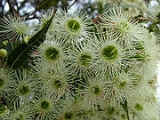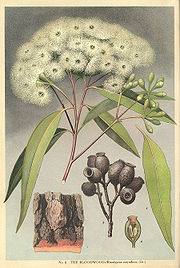
Corymbia gummifera
Encyclopedia
Corymbia gummifera, commonly known as Red Bloodwood, is a hardwood
tree native to eastern Australia
.
 It usually grows as a tree
It usually grows as a tree
, but may take the form of a mallee
in very poor soils. As a tree it typically grows to a height of 20 to 34 metres and a trunk diameter of one metre dbh
. However, exceptional trees may reach 60 metres high at four metres dbh. It has persistent fibrous bark typical of bloodwood
s, and glossy dark green leaves, ten to 14 centimetres long and2–3.5 centimetres wide. Flowers occur in an inflorescence
of three to seven umbel
s.
in 1788. Despite this, the species was republished as Eucalyptus corymbosa by James Edward Smith
in his 1793 A Specimen of the Botany of New Holland
, as Eucalyptus corymbosus by Cavanilles in 1797, as Eucalyptus oppositifolia by Desfontaines in 1804, as Eucalyptus purpurascens var. petiolaris by de Candolle in 1828; and as Eucalyptus longifolia by Joseph Maiden
in 1920. The precedence of Metrosideros gummifera was recognised in 1925 by Hochreutiner, who transferred it into Eucalyptus as Eucalyptus gummifera. In 1995, the Eucalyptus genus was split into three genera by K.D.Hill and L.A.S.Johnson
, with E. gummifera transferred in Corymbia. However some botanists continue to recognise a single Eucalyptus sensu lato genus, and so retain the name Eucalyptus gummifera.
and south-eastern Queensland
. It grows best on moist, rich, loamy soil, but is also commonly found on poorer sandy soils.
Hardwood
Hardwood is wood from angiosperm trees . It may also be used for those trees themselves: these are usually broad-leaved; in temperate and boreal latitudes they are mostly deciduous, but in tropics and subtropics mostly evergreen.Hardwood contrasts with softwood...
tree native to eastern Australia
Australia
Australia , officially the Commonwealth of Australia, is a country in the Southern Hemisphere comprising the mainland of the Australian continent, the island of Tasmania, and numerous smaller islands in the Indian and Pacific Oceans. It is the world's sixth-largest country by total area...
.
Description

Tree
A tree is a perennial woody plant. It is most often defined as a woody plant that has many secondary branches supported clear of the ground on a single main stem or trunk with clear apical dominance. A minimum height specification at maturity is cited by some authors, varying from 3 m to...
, but may take the form of a mallee
Mallee (habit)
Mallee is the growth habit of certain eucalypt species that grow with multiple stems springing from an underground lignotuber, usually to a height of no more than ten metres...
in very poor soils. As a tree it typically grows to a height of 20 to 34 metres and a trunk diameter of one metre dbh
Diameter at breast height
Diameter at breast height, or DBH, is a standard method of expressing the diameter of the trunk or bole of a standing tree. DBH is one of the most common dendrometric measurements....
. However, exceptional trees may reach 60 metres high at four metres dbh. It has persistent fibrous bark typical of bloodwood
Bloodwood
Bloodwood has several meanings. It is the name of a dark red wood, from South America. It is also a common name for several unrelated groups of trees, for instance:* Brosimum paraense, a tree found in Central and South America...
s, and glossy dark green leaves, ten to 14 centimetres long and2–3.5 centimetres wide. Flowers occur in an inflorescence
Inflorescence
An inflorescence is a group or cluster of flowers arranged on a stem that is composed of a main branch or a complicated arrangement of branches. Strictly, it is the part of the shoot of seed plants where flowers are formed and which is accordingly modified...
of three to seven umbel
Umbel
An umbel is an inflorescence which consists of a number of short flower stalks which are equal in length and spread from a common point, somewhat like umbrella ribs....
s.
Taxonomy
C. gummifera was first published as Metrosideros gummifera by Joseph GaertnerJoseph Gaertner
Joseph Gaertner was a German botanist, best known for his work on seeds, De Fructibus et Seminibus Plantarum ....
in 1788. Despite this, the species was republished as Eucalyptus corymbosa by James Edward Smith
James Edward Smith
Sir James Edward Smith was an English botanist and founder of the Linnean Society.Smith was born in Norwich in 1759, the son of a wealthy wool merchant. He displayed a precocious interest in the natural world...
in his 1793 A Specimen of the Botany of New Holland
A specimen of the botany of New Holland
A Specimen of the Botany of New Holland, also known by its standard abbreviation Spec. Bot. New Holland, was the first published book on the flora of Australia. Written by James Edward Smith and illustrated by James Sowerby, it was published by Sowerby in four parts between 1793 and 1795...
, as Eucalyptus corymbosus by Cavanilles in 1797, as Eucalyptus oppositifolia by Desfontaines in 1804, as Eucalyptus purpurascens var. petiolaris by de Candolle in 1828; and as Eucalyptus longifolia by Joseph Maiden
Joseph Maiden
Joseph Henry Maiden was a botanist who made a major contribution to knowledge of the Australian flora, especially the Eucalyptus genus. This botanist is denoted by the author abbreviation Maiden when citing a botanical name.Joseph Maiden was born in St John's Wood, London...
in 1920. The precedence of Metrosideros gummifera was recognised in 1925 by Hochreutiner, who transferred it into Eucalyptus as Eucalyptus gummifera. In 1995, the Eucalyptus genus was split into three genera by K.D.Hill and L.A.S.Johnson
Lawrence Alexander Sidney Johnson
Lawrence Alexander Sidney Johnson, known as Lawrie Johnson, was an Australian taxonomic botanist. He worked at the Royal Botanic Gardens, Sydney, for the whole of his professional career, as a botanist , Director and Honorary Research Associate .Alone or in collaboration with colleagues, he...
, with E. gummifera transferred in Corymbia. However some botanists continue to recognise a single Eucalyptus sensu lato genus, and so retain the name Eucalyptus gummifera.
Distribution and habitat
It mainly occurs on flats and low hills along the coast between the extreme eastern corner of VictoriaVictoria (Australia)
Victoria is the second most populous state in Australia. Geographically the smallest mainland state, Victoria is bordered by New South Wales, South Australia, and Tasmania on Boundary Islet to the north, west and south respectively....
and south-eastern Queensland
Queensland
Queensland is a state of Australia, occupying the north-eastern section of the mainland continent. It is bordered by the Northern Territory, South Australia and New South Wales to the west, south-west and south respectively. To the east, Queensland is bordered by the Coral Sea and Pacific Ocean...
. It grows best on moist, rich, loamy soil, but is also commonly found on poorer sandy soils.

